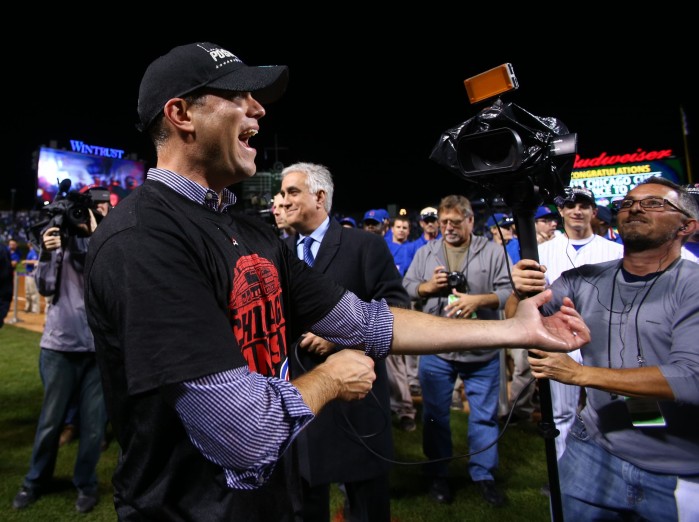By now, it has become pretty clear that the Brewers won’t vie for the NL Central pennant this upcoming season. Sure, they’ve imported a boatload of fascinating future talent — but in doing so, they’ve given up a tremendous amount of present talent. During the 2016 season, and perhaps in 2017, the Brewers will bring mediocrity at best and borderline atrocities at worst. Theoretically, this depressing and disorienting tunnel will give way to light in a few years; for now, however, we’ll have to endure the dark.
A few years ago, two of the Brewers’ NL Central foes — the Astros and Cubs — found themselves at similar developmental points. Both clubs had begun to rebuild by selling off their more attractive players, while stockpiling prospects for the future. After several seasons near the bottom of the league, each began to reap the rewards of their patience in 2015, and each appears poised to maintain their prosperity for at least the rest of the decade.
They didn’t arrive at this destination in the same manner, though. In terms of their rebuilding strategy, one integral difference between Houston and Chicago materialized early on: The former went for a complete teardown, whereas the latter stuck with a more traditional plan. Now that the dust has settled, what can Milwaukee take from this? Which model should it hew to?
Well, many in the sabermetric community have praised the Astros for their tenacity. During the 2011 and 2012 offseasons, they traded away anyone with a pulse and flatly refused to sign free agents. In a 2013 Sports Illustrated cover story, G.M. Jeff Luhnow outlined the team’s mindset:
“When you’re in 2017, you don’t really care that much about whether you lost 98 or 107 in 2012. You care about how close we are to winning a championship in 2017.”
Aside from the fan alienation (and possible player contempt) that can stem from constant losing, the miserly approach has a direct consequence. It prevents the team from acquiring more assets via trade. Sports Illustrated may have derided the “cosmetic decision” of “wasting money on a free agent,” but that choice can pay off several years down the road. Three moves that the Cubs made in the past have given them useful contributors in the present — and a pair of their brightest stars.
Let’s back up to the 2011 offseason. At the same time that the Astros tore their organization down, the Cubs signed left-hander Paul Maholm to a one-year contract with a team option. Would the Houston Astros have done the same? Probably not, since they had their sites set on tanking. But Chicago didn’t ink Maholm to improve their record — they did so in the hopes that they could trade him later. Sure enough, he posted a solid 3.74 ERA for the North Siders in a half-season of work, which they parlayed into a swap with the Braves.
The next two offseasons saw the Cubs repeat this maneuver. In 2012, they brought in Scott Feldman on a one-year deal, then flipped him to the Orioles the next July. In 2013, they took a flyer on Jason Hammel, whom they shipped to the Athletics (along with Jeff Samardzija) over the summer. The Chicago ERAs of those pitchers were 3.46 and 2.98, respectively, which ensured that they would net a lucrative return (more on that in a moment).
Maholm, Feldman, and Hammel shared some common traits. All had inconsistent track records prior to their arrival in the Windy City, with ERAs in the mid-fours and a fair share of injuries. This lowered their price considerably, making their signings low-risk and high-reward. And, man, has that reward been high. Because of that trade trio, the following men now play for the Cubs:
- Tommy La Stella
- Pedro Strop
- Jake Arrieta
- Addison Russell
- Billy McKinney
There, you have one of the best starting pitchers in baseball (Arrieta); one of the best young infielders in baseball (Russell); a top-notch middle reliever (Strop); a respectable utility player (La Stella); and a 21-year-old speedster with Major League potential (McKinney). That’s a formidable assembly of talent — and one that Chicago likely wouldn’t possess if it had taken the Houston path.
Will the Brewers follow in the Cubs’ footsteps? Based on some of their recent decisions, that looks likely. A couple months ago, they imported Jonathan Villar, a somewhat-established Major Leaguer with upside. He’ll give them a dependable infield option, which they can either trade to a contending team or hold on to as Jean Segura’s replacement if he departs. And on Wednesday, they signed Chris Carter, a similarly intriguing player who would also bring back some notable talent. These transactions make it seem that Milwaukee could take the Chicago road.
Still, there are several other players available now who could further this mission. Mat Latos, for instance, might come on a two-year deal, which would sweeten the pot for a starter-hungry club if he regains his old form. (Last week, my colleague Colin Anderle suggested that the Brewers sign Latos for this reason.) Doug Fister could bounce back from a rough 2015, as could Steve Pearce, Alexei Ramirez, Bud Norris, or any number of similar players. Rebuilding gives a team the opportunity to take chances on these lottery tickets, which can occasionally hit the jackpot.
Obviously, the Brewers have little chance of acquiring a future Cy Young winner with any potential trade. Most lottery tickets don’t win; luck had a lot to do with the Cubs’ success in that regard. With that said, you can’t win the game if you don’t play. A complete fire sale and a period of inaction can lead to a better tomorrow, but some shrewd decisions can make that tomorrow even better.

1 comment on “The Brewers Should Take The Cubs’ Rebuilding Approach”